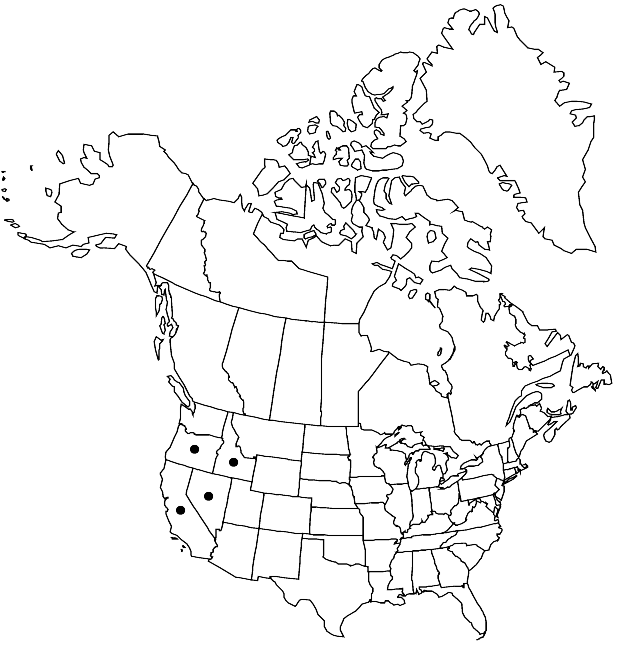Difference between revisions of "Thelypodium flexuosum"
in A. Gray et al., Syn. Fl. N. Amer. 1(1,1): 175. 1895.
FNA>Volume Importer |
imported>Volume Importer |
||
| (4 intermediate revisions by 2 users not shown) | |||
| Line 1: | Line 1: | ||
{{Treatment/ID | {{Treatment/ID | ||
|accepted_name=Thelypodium flexuosum | |accepted_name=Thelypodium flexuosum | ||
| − | |accepted_authority=B. L. Robinson | + | |accepted_authority=B. L. Robinson |
|publications={{Treatment/Publication | |publications={{Treatment/Publication | ||
|title=in A. Gray et al., Syn. Fl. N. Amer. | |title=in A. Gray et al., Syn. Fl. N. Amer. | ||
|place=1(1,1): 175. 1895 | |place=1(1,1): 175. 1895 | ||
|year=1895 | |year=1895 | ||
| + | }} | ||
| + | |special_status={{Treatment/ID/Special_status | ||
| + | |code=E | ||
| + | |label=Endemic | ||
}} | }} | ||
|basionyms= | |basionyms= | ||
| Line 31: | Line 35: | ||
-->{{#Taxon: | -->{{#Taxon: | ||
name=Thelypodium flexuosum | name=Thelypodium flexuosum | ||
| − | + | |authority=B. L. Robinson | |
| − | |authority=B. L. Robinson | ||
|rank=species | |rank=species | ||
|parent rank=genus | |parent rank=genus | ||
| Line 45: | Line 48: | ||
|publication title=in A. Gray et al., Syn. Fl. N. Amer. | |publication title=in A. Gray et al., Syn. Fl. N. Amer. | ||
|publication year=1895 | |publication year=1895 | ||
| − | |special status= | + | |special status=Endemic |
| − | |source xml=https:// | + | |source xml=https://bitbucket.org/aafc-mbb/fna-data-curation/src/2e0870ddd59836b60bcf96646a41e87ea5a5943a/coarse_grained_fna_xml/V7/V7_1274.xml |
|tribe=Brassicaceae tribe Thelypodieae | |tribe=Brassicaceae tribe Thelypodieae | ||
|genus=Thelypodium | |genus=Thelypodium | ||
Latest revision as of 22:31, 5 November 2020
Perennials; (caudex woody, covered with persistent petiolar remains); somewhat glaucous, glabrous throughout. Stems (often subdecumbent), branched basally, (flexuous), 1.5–5.6(–8.5) dm. Basal leaves: petiole 1–6.5(–13) cm; blade often lanceolate, sometimes oblong or oblanceolate, (2–)3.5–16.5(–20.5) cm × (5–)10–25(–45) mm, margins entire. Cauline leaves (ascending); sessile; blade lanceolate to linear, 1–7(–11) cm × 2–7(–14) mm, (base sagittate to somewhat amplexicaul), margins entire. Racemes (few-flowered, corymbose), elongated in fruit, (flower buds oblong). Fruiting pedicels usually horizontal to divaricate, rarely divaricate-ascending, straight or slightly curved upward, slender, (2.5–)4–9(–16) mm, slightly flattened at base. Flowers: sepals erect, oblong, 3–4(–4.5) × 1–1.5(–1.7) mm; petals lavender or white, often spatulate, sometimes oblanceolate or obovate, 6–9(–10) × (1.5–)2–3(–3.5) mm, margins not crisped, claw strongly differentiated from blade, (slender, 2–3.5(–4) mm, narrowest at base); nectar glands lateral, median glands absent; filaments tetradynamous, median pairs 3–4(–5) mm, lateral pair 2–3.5(–4) mm; anthers included, oblong, 1–2(–2.5) mm, not circinately coiled; gynophore (stout), 0.5–1 mm. Fruits erect to ascending, torulose, slightly incurved or straight, terete, 1–2.5(–4.2) cm × 0.8–1(–1.5) mm; ovules 12–30 per ovary; style cylindrical, (0.3–)1–2(–3) mm. Seeds (1–)1.3–1.5 × 0.5–8(–1) mm. 2n = 26.
Phenology: Flowering Apr–Jun.
Habitat: Often tangled among woody shrubs in moderately to strongly alkaline sandy loam or clay, open deserts
Elevation: 1000-2400 m
Distribution

Calif., Idaho, Nev., Oreg.
Discussion
Selected References
None.